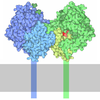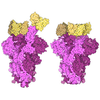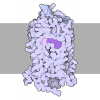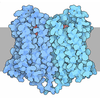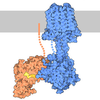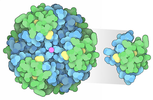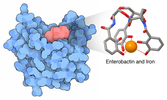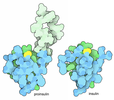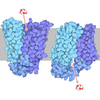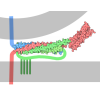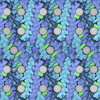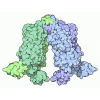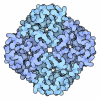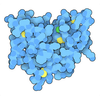+ データを開く
データを開く
- 基本情報
基本情報
| 登録情報 | データベース: PDB / ID: 9ast | ||||||
|---|---|---|---|---|---|---|---|
| タイトル | Cryo-EM structure of XCR1 signaling complex | ||||||
 要素 要素 |
| ||||||
 キーワード キーワード | SIGNALING PROTEIN / GPCR / XCL1 / Membrane protein | ||||||
| 機能・相同性 |  機能・相同性情報 機能・相同性情報mature natural killer cell chemotaxis / positive regulation of granzyme A production / negative regulation of T-helper 1 cell activation / positive regulation of immunoglobulin production in mucosal tissue / positive regulation of granzyme B production / positive regulation of thymocyte migration / positive regulation of B cell chemotaxis / negative regulation of T cell cytokine production / negative regulation of T-helper 1 type immune response / positive regulation of transforming growth factor beta production ...mature natural killer cell chemotaxis / positive regulation of granzyme A production / negative regulation of T-helper 1 cell activation / positive regulation of immunoglobulin production in mucosal tissue / positive regulation of granzyme B production / positive regulation of thymocyte migration / positive regulation of B cell chemotaxis / negative regulation of T cell cytokine production / negative regulation of T-helper 1 type immune response / positive regulation of transforming growth factor beta production / positive regulation of natural killer cell chemotaxis / chemokine receptor binding / positive regulation of T-helper 1 cell cytokine production / chemokine receptor activity / positive regulation of T cell chemotaxis / CCR chemokine receptor binding / positive regulation of T-helper 2 cell cytokine production / positive regulation of leukocyte chemotaxis / C-C chemokine receptor activity / negative regulation of CD4-positive, alpha-beta T cell proliferation / chemokine-mediated signaling pathway / C-C chemokine binding / positive regulation of CD4-positive, alpha-beta T cell proliferation / positive regulation of neutrophil chemotaxis / chemokine activity / Chemokine receptors bind chemokines / positive regulation of CD8-positive, alpha-beta T cell proliferation / negative regulation of interleukin-2 production / negative regulation of type II interferon production / positive regulation of interleukin-10 production / G protein-coupled receptor signaling pathway, coupled to cyclic nucleotide second messenger / adenylate cyclase inhibitor activity / cellular response to transforming growth factor beta stimulus / positive regulation of protein localization to cell cortex / T cell migration / Adenylate cyclase inhibitory pathway / D2 dopamine receptor binding / response to prostaglandin E / G protein-coupled serotonin receptor binding / adenylate cyclase regulator activity / adenylate cyclase-inhibiting serotonin receptor signaling pathway / release of sequestered calcium ion into cytosol / neutrophil chemotaxis / cellular response to forskolin / cellular response to interleukin-4 / regulation of mitotic spindle organization / positive regulation of release of sequestered calcium ion into cytosol / cell chemotaxis / Regulation of insulin secretion / positive regulation of cholesterol biosynthetic process / negative regulation of insulin secretion / G protein-coupled receptor binding / calcium-mediated signaling / adenylate cyclase-inhibiting G protein-coupled receptor signaling pathway / positive regulation of T cell cytokine production / response to peptide hormone / adenylate cyclase-modulating G protein-coupled receptor signaling pathway / positive regulation of T cell mediated cytotoxicity / G-protein beta/gamma-subunit complex binding / response to virus / centriolar satellite / Olfactory Signaling Pathway / Activation of the phototransduction cascade / G beta:gamma signalling through PLC beta / Presynaptic function of Kainate receptors / Thromboxane signalling through TP receptor / G protein-coupled acetylcholine receptor signaling pathway / G-protein activation / Activation of G protein gated Potassium channels / Inhibition of voltage gated Ca2+ channels via Gbeta/gamma subunits / Prostacyclin signalling through prostacyclin receptor / G beta:gamma signalling through CDC42 / Glucagon signaling in metabolic regulation / G beta:gamma signalling through BTK / Synthesis, secretion, and inactivation of Glucagon-like Peptide-1 (GLP-1) / chemotaxis / ADP signalling through P2Y purinoceptor 12 / Sensory perception of sweet, bitter, and umami (glutamate) taste / photoreceptor disc membrane / antimicrobial humoral immune response mediated by antimicrobial peptide / Glucagon-type ligand receptors / Adrenaline,noradrenaline inhibits insulin secretion / Vasopressin regulates renal water homeostasis via Aquaporins / GDP binding / G alpha (z) signalling events / Glucagon-like Peptide-1 (GLP1) regulates insulin secretion / cellular response to catecholamine stimulus / ADP signalling through P2Y purinoceptor 1 / ADORA2B mediated anti-inflammatory cytokines production / G beta:gamma signalling through PI3Kgamma / Cooperation of PDCL (PhLP1) and TRiC/CCT in G-protein beta folding / adenylate cyclase-activating dopamine receptor signaling pathway / GPER1 signaling / Inactivation, recovery and regulation of the phototransduction cascade / cellular response to prostaglandin E stimulus / G-protein beta-subunit binding / heterotrimeric G-protein complex / G alpha (12/13) signalling events / cell-cell signaling / sensory perception of taste 類似検索 - 分子機能 | ||||||
| 生物種 |  Homo sapiens (ヒト) Homo sapiens (ヒト) | ||||||
| 手法 | 電子顕微鏡法 / 単粒子再構成法 / クライオ電子顕微鏡法 / 解像度: 3.07 Å | ||||||
 データ登録者 データ登録者 | Zhang, X. / Zhang, C. | ||||||
| 資金援助 |  米国, 1件 米国, 1件
| ||||||
 引用 引用 |  ジャーナル: Proc Natl Acad Sci U S A / 年: 2024 ジャーナル: Proc Natl Acad Sci U S A / 年: 2024タイトル: Molecular basis for chemokine recognition and activation of XCR1. 著者: Xuan Zhang / Roman R Schlimgen / Stephanie Singh / Michael P Tomani / Brian F Volkman / Cheng Zhang /  要旨: The X-C motif chemokine receptor XCR1, which selectively binds to the chemokine XCL1, is highly expressed in conventional dendritic cells subtype 1 (cDC1s) and crucial for their activation. ...The X-C motif chemokine receptor XCR1, which selectively binds to the chemokine XCL1, is highly expressed in conventional dendritic cells subtype 1 (cDC1s) and crucial for their activation. Modulating XCR1 signaling in cDC1s could offer novel opportunities in cancer immunotherapy and vaccine development by enhancing the antigen presentation function of cDC1s. To investigate the molecular mechanism of XCL-induced XCR1 signaling, we determined a high-resolution structure of the human XCR1 and G complex with an engineered form of XCL1, XCL1 CC3, by cryoelectron microscopy. Through mutagenesis and structural analysis, we elucidated the molecular details for the binding of the N-terminal segment of XCL1 CC3, which is vital for activating XCR1. The unique arrangement within the XCL1 CC3 binding site confers specificity for XCL1 in XCR1. We propose an activation mechanism for XCR1 involving structural alterations of key residues at the bottom of the XCL1 binding pocket. These detailed insights into XCL1 CC3-XCR1 interaction and XCR1 activation pave the way for developing novel XCR1-targeted therapeutics. | ||||||
| 履歴 |
|
- 構造の表示
構造の表示
| 構造ビューア | 分子:  Molmil Molmil Jmol/JSmol Jmol/JSmol |
|---|
- ダウンロードとリンク
ダウンロードとリンク
- ダウンロード
ダウンロード
| PDBx/mmCIF形式 |  9ast.cif.gz 9ast.cif.gz | 245.2 KB | 表示 |  PDBx/mmCIF形式 PDBx/mmCIF形式 |
|---|---|---|---|---|
| PDB形式 |  pdb9ast.ent.gz pdb9ast.ent.gz | 185.8 KB | 表示 |  PDB形式 PDB形式 |
| PDBx/mmJSON形式 |  9ast.json.gz 9ast.json.gz | ツリー表示 |  PDBx/mmJSON形式 PDBx/mmJSON形式 | |
| その他 |  その他のダウンロード その他のダウンロード |
-検証レポート
| 文書・要旨 |  9ast_validation.pdf.gz 9ast_validation.pdf.gz | 1.1 MB | 表示 |  wwPDB検証レポート wwPDB検証レポート |
|---|---|---|---|---|
| 文書・詳細版 |  9ast_full_validation.pdf.gz 9ast_full_validation.pdf.gz | 1.1 MB | 表示 | |
| XML形式データ |  9ast_validation.xml.gz 9ast_validation.xml.gz | 40.1 KB | 表示 | |
| CIF形式データ |  9ast_validation.cif.gz 9ast_validation.cif.gz | 59.9 KB | 表示 | |
| アーカイブディレクトリ |  https://data.pdbj.org/pub/pdb/validation_reports/as/9ast https://data.pdbj.org/pub/pdb/validation_reports/as/9ast ftp://data.pdbj.org/pub/pdb/validation_reports/as/9ast ftp://data.pdbj.org/pub/pdb/validation_reports/as/9ast | HTTPS FTP |
-関連構造データ
| 関連構造データ |  43825MC M: このデータのモデリングに利用したマップデータ C: 同じ文献を引用 ( |
|---|---|
| 類似構造データ | 類似検索 - 機能・相同性  F&H 検索 F&H 検索 |
- リンク
リンク
- 集合体
集合体
| 登録構造単位 | 
|
|---|---|
| 1 |
|
- 要素
要素
-Guanine nucleotide-binding protein ... , 3種, 3分子 ABG
| #1: タンパク質 | 分子量: 40414.047 Da / 分子数: 1 / 変異: S47N, G203A, E245A, A326S / 由来タイプ: 組換発現 / 由来: (組換発現)  Homo sapiens (ヒト) / 遺伝子: GNAI1 Homo sapiens (ヒト) / 遺伝子: GNAI1発現宿主:  参照: UniProt: P63096 |
|---|---|
| #4: タンパク質 | 分子量: 38744.371 Da / 分子数: 1 / 由来タイプ: 組換発現 / 由来: (組換発現)  Homo sapiens (ヒト) / 遺伝子: GNB1 Homo sapiens (ヒト) / 遺伝子: GNB1発現宿主:  参照: UniProt: P62873 |
| #5: タンパク質 | 分子量: 7859.173 Da / 分子数: 1 / 由来タイプ: 組換発現 / 由来: (組換発現)  Homo sapiens (ヒト) / 遺伝子: GNG2 Homo sapiens (ヒト) / 遺伝子: GNG2発現宿主:  参照: UniProt: P59768 |
-タンパク質 , 2種, 2分子 LR
| #2: タンパク質 | 分子量: 13905.371 Da / 分子数: 1 / 由来タイプ: 組換発現 / 由来: (組換発現)  Homo sapiens (ヒト) / 遺伝子: XCL1, LTN, SCYC1 Homo sapiens (ヒト) / 遺伝子: XCL1, LTN, SCYC1発現宿主:  参照: UniProt: P47992 |
|---|---|
| #3: タンパク質 | 分子量: 60383.625 Da / 分子数: 1 / 由来タイプ: 組換発現 / 由来: (組換発現)  Homo sapiens (ヒト) / 遺伝子: XCR1, CCXCR1, GPR5 Homo sapiens (ヒト) / 遺伝子: XCR1, CCXCR1, GPR5発現宿主:  参照: UniProt: P46094, UniProt: A0A482LYE4 |
-抗体 , 1種, 1分子 E
| #6: 抗体 | 分子量: 28634.797 Da / 分子数: 1 / 由来タイプ: 組換発現 / 由来: (組換発現)  発現宿主:  |
|---|
-詳細
| Has protein modification | Y |
|---|
-実験情報
-実験
| 実験 | 手法: 電子顕微鏡法 |
|---|---|
| EM実験 | 試料の集合状態: PARTICLE / 3次元再構成法: 単粒子再構成法 |
- 試料調製
試料調製
| 構成要素 | 名称: XCL1-XCR1-Gi complex / タイプ: COMPLEX / Entity ID: all / 由来: RECOMBINANT |
|---|---|
| 分子量 | 実験値: NO |
| 由来(天然) | 生物種:  |
| 由来(組換発現) | 生物種:  Baculovirus expression vector pFastBac1-HM (ウイルス) Baculovirus expression vector pFastBac1-HM (ウイルス) |
| 緩衝液 | pH: 7.5 |
| 試料 | 包埋: NO / シャドウイング: NO / 染色: NO / 凍結: YES |
| 急速凍結 | 凍結剤: ETHANE |
- 電子顕微鏡撮影
電子顕微鏡撮影
| 実験機器 | 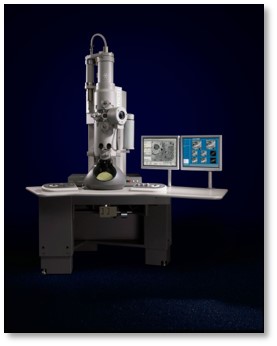 モデル: Tecnai Spirit / 画像提供: FEI Company |
|---|---|
| 顕微鏡 | モデル: FEI TECNAI SPIRIT |
| 電子銃 | 電子線源:  FIELD EMISSION GUN / 加速電圧: 300 kV / 照射モード: FLOOD BEAM FIELD EMISSION GUN / 加速電圧: 300 kV / 照射モード: FLOOD BEAM |
| 電子レンズ | モード: BRIGHT FIELD / 最大 デフォーカス(公称値): 2000 nm / 最小 デフォーカス(公称値): 1000 nm |
| 撮影 | 電子線照射量: 55 e/Å2 フィルム・検出器のモデル: GATAN K3 BIOQUANTUM (6k x 4k) |
- 解析
解析
| CTF補正 | タイプ: PHASE FLIPPING AND AMPLITUDE CORRECTION |
|---|---|
| 3次元再構成 | 解像度: 3.07 Å / 解像度の算出法: FSC 0.143 CUT-OFF / 粒子像の数: 255110 / 対称性のタイプ: POINT |
 ムービー
ムービー コントローラー
コントローラー



 PDBj
PDBj